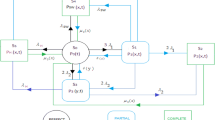Abstract
The paper deals with the availability analysis of a system, which consists of two subsystems namely subsystem-1 and subsystem-2. Subsystem-1 is working under k-out of n: good configuration while subsystem-2 has two identical units connected in parallel configuration. A controller is attached with each subsystem for proper functioning of the system. All failure rates are constant but repairs follow general and exponential distributions. The transitional state probabilities, asymptotic behavior and some characteristics such as reliability, availability, MTTF and the cost effectiveness of the system have been evaluated with the help of supplementary variable technique, Laplace transformations and copula methodology. At last, some particular cases and numerical examples have been taken to describe the model.




Similar content being viewed by others
References
Cox DR (1955) The analysis of non-Markov stochastic processes by the inclusion of supplementary variables. Proc Camb Philos Soc 51:433–441
Dhillon BS, Liu Y (2006) Human error in maintenance: a review. J Qual Mainten Eng 12(1):21–36
Dhillon BS, Yang N (1992) Stochastic analysis of standby systems with common cause failures and human errors. Microelectron Reliab 32(12):1699–1712
Dhillon BS, Yang N (1993) Availability of a man-machine system with critical and non-critical human error. Microelectron Reliab 33(10):1511–1521
Giuntini RE (2000) Mathematical characterization of human reliability for multi-task system operations. In: IEEE international conference on systems, man and cybernetics, vol 2, p 1329–1329
Govil AK (1974) Operational behaviour of a complex system having shelf-life of the components under preemptive-resume repair discipline. Microelectron Reliab 13:97–101
Gupta PP, Sharma MK (1993) Reliability and M.T.T.F evaluation of a two duplex-unit standby system with two types of repair. Microelectron Reliab 33(3):291–295
Melchiori MR (2003) Which Archimedean copula is right one? e-journal, 3rd edn, p 1–18 http://www.YieldCurve.com
Nelsen RB (2006) An introduction to copulas, 2nd edn. Springer, New York
Ogata K. (2009) Modern control engineering, 5th edn, Prentice Hall Publisher. ISBN-10: 0136156738, ISBN-13: 9780136156734
Oliveira EA, Alvim ACM, Frutuoso e Melo PF (2005) Unavailability analysis of safety systems under aging by supplementary variables with imperfect repair. Ann Nucl Energy 32:241–252
Ram M, Singh SB (2008) Availability and cost analysis of a parallel redundant complex system with two types of failure under preemptive-resume repair discipline using Gumbel-Hougaard family copula in repair. Int J Reliab Qual Saf Eng 15(4):341–365
Ram M, Singh SB (2009) Analysis of reliability characteristics of a complex engineering system under copula. J Reliab Stat Stud 2(1):91–102
Ram M, Singh SB (2010) Availability, MTTF and cost analysis of complex system under preemptive-repeat repair discipline using Gumbel-Hougaard family copula. Int J Qual Reliab Manag 27(5):576–595
Singh SK, Singh RP, Singh RB (1992) Profit evaluation in two units cold standby system having two types of independent repair facilities. IJOMAS 8:277–288
Singh SB, Gupta PP, Goel CK (2001) Analytical study of a complex stands by redundant systems involving the concept of multi-failure human failure under head-of-line repair policy. Bull Pure Appl Sci 20(2):345–351
Verma AK, Ajit S, Karanki DR (2010) Reliability and safety engineering, 1st edn, Springer Publishers, London. ISBN: 978-1-84996-231-5
Zhang X, Pham H, Johnson CR (2010) Reliability models for systems with internal and external redundancy. Int J Syst Assur Eng Manag 1(4):362–369
Author information
Authors and Affiliations
Corresponding author
Appendices
Appendix 1
Equation 1 has been obtained by limiting case of following probabilistic difference equation:
Now \( \mathop {\lim }\limits_{\Updelta t \to 0\;} \;\frac{{P_{0} (t + \Updelta ) - P_{0} (t)}}{\Updelta t} + (\lambda_{1} + \lambda_{C} + \lambda_{CB} + \lambda_{h} + 2\lambda ) \cdots = \int\limits_{0}^{\infty } {\phi (x)P_{1} (x,t)} {{dx}} + \cdots P_{0} (t) \) yield Eq. 1 and similarly Eqs. 2–10 have been obtained.
Appendix 2
where
This implies that
. So on. Using values obtained by solving 22–30, one can get the transition state probabilities of the system.
Appendix 3
We have
when s = 0, D(s) becomes zero and \( P_{0} (0) = \mathop {\lim }\nolimits_{s \to 0} sP_{0} (s) = \mathop {\lim }\nolimits_{s \to 0} \frac{s}{{{{D}}(s)}} = \frac{1}{{{{D}}^{ '} (0)}} \) by D’L Hospital rule \( S_{\phi } (s) = \int\nolimits_{0}^{\infty } {e^{ - sx} } \phi (x)e^{{\int\nolimits_{0}^{x} {\phi (x){{dx}}} }} {{dx}} = \frac{\phi }{s + \phi } \) implies that \( S_{\phi } (0)\; = \frac{\phi }{0 + \phi } = 1 \)and so on.
Rights and permissions
About this article
Cite this article
Singh, V.V., Singh, S.B., Mangey Ram et al. Availability, MTTF and cost analysis of a system having two units in series configuration with controller. Int J Syst Assur Eng Manag 4, 341–352 (2013). https://doi.org/10.1007/s13198-012-0102-0
Received:
Revised:
Published:
Issue Date:
DOI: https://doi.org/10.1007/s13198-012-0102-0




